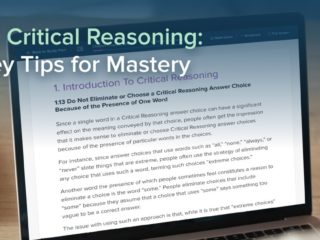| Getting your Trinity Audio player ready... |
Last Updated on April 30, 2023
Test-takers are often nervous about the Verbal section of the GRE because they know it requires learning many vocabulary words. However, what students may not realize until they dive into their test prep is that the GRE tests vocabulary in some pretty tricky ways.
One of the primary ways you’ll encounter GRE vocabulary on test day is in Text Completion (TC) questions. These Verbal questions test not only your knowledge of GRE words but also your ability to discern their meanings in different contexts and identify whether they fit the logic of a passage.
Fortunately, there are some simple yet highly effective GRE Text Completion strategies — beyond studying vocab — that students can use to significantly improve their performance on GRE Text Completion questions.
In this article, I’ll share my top 5 GRE Text Completion tips. You can start integrating these strategies into your Verbal prep today, regardless of how far along you are in your study of GRE vocabulary.
Here are all the topics we’ll cover:
First, let’s review what exactly GRE Text Completion questions are.
What Is Text Completion in GRE Verbal?
Text Completion is one of three major question types in the GRE Verbal section. Sentence Equivalence (SE) and Reading Comprehension (RC) are the other two. Approximately half of the questions you see in each GRE Verbal section will be either TC or SE questions. The other half will be RC questions.
So then, roughly 1/3 of the Verbal questions you see on the GRE are Text Completion. Thus, mastering Text Completion questions is an essential aspect of earning a high GRE score in Verbal.
There are also three different kinds of Text Completion questions: one-blank, two-blank, and three-blank. One-blank questions are always one sentence long and present five answer choices. Two-blank and three-blank questions may be either a single sentence or multiple sentences long. Those questions present three answer choices per blank. Notably, Text Completion questions are never more than a few sentences long.
Whichever variety of TC question you see, your job is always the same. You must fill in the blank(s) with the word(s) from among the answer choices that logically completes the passage.
KEY FACT:
Roughly 1/3 of the Verbal questions you see on GRE test day will be Text Completion.
Now, let’s discuss how to master Text Completion GRE Verbal questions with my top 5 tips.
Top 5 GRE Text Completion Tips
The following 5 GRE Text Completion tips will help you perform better on TC questions, regardless of your current level of vocabulary skill. Of course, GRE vocabulary knowledge is essential to your success in Text Completion. However, vocabulary is just one piece of the puzzle. Without smart strategies for analyzing the logic of sentences and efficiently answering TC questions, at a certain point, your performance in Text Completion is likely to stall even as you improve your vocab knowledge.
TTP PRO TIP:
In addition to vocabulary knowledge, you’ll need smart strategies for analyzing the logic of sentences and efficiently answering questions in order to master Text Completion.
Tip 1: Structural Keywords Are Your Secret Weapon
Structural keywords appear in virtually all Text Completion sentences. Though often overlooked, these keywords are one of the powerful weapons at your disposal for finding correct answers to TC questions.
So, what are structural keywords? Structural keywords are common words and phrases that indicate how different parts of a sentence, or different sentences, logically relate. For instance, keywords such as but, yet, although, and despite signal a contrast between ideas, as in the following sentence:
We had planned to have a picnic in the park, but the rain kept us indoors.
In the sentence above, the plan to have a picnic in the park contrasts with the fact that rain kept the “we” in the sentence indoors.
Signaling contrast is just one possible function that structural keywords can perform. They can also signal agreement between ideas, introduce examples, convey opinions, show cause and effect, express surprise, and more.
The good news is that, once you learn to recognize structural keywords and what they indicate, you’ll be able to understand the logic of Text Completion sentences much more efficiently. Thus, you’ll be able to find correct answers more quickly and reliably.
So, be sure you have a GRE study resource that teaches you the various structural keywords and their uses. Then, look out for those words when you answer TC practice questions.
TTP PRO TIP:
Use structural keywords in Text Completion sentences to understand how the ideas presented relate to each other, and thus which words will logically fill the blanks.
Tip 2: Don’t Hover Around the Blanks
Particularly when students first begin their Text Completion practice, they tend to want to hover around the blanks in sentences when trying to answer questions. This inclination is only natural; after all, the blank is the part of the sentence we need to “solve.” So, we’re going to want to look closely at that part.
Here’s the thing: the part of the sentence containing the blank presents incomplete information. So, by hovering around that part of the sentence and not paying much attention to the part that is already “filled in” for us, we’re working at a disadvantage. In other words, we’re ignoring completed information in favor of something incomplete!
To illustrate this point, let’s consider the following Text Completion sample question.
Sample Question
The mayor opted to uphold the curfew, despite relentless pressure from residents to __________ it.
- maintain
- endorse
- attempt
- promote
- rescind
First, notice the structural keyword “despite.” This keyword signals a contrast between the fact that the mayor “opted to uphold the curfew” and the fact that there was “relentless pressure from residents” to take some action related to the curfew.
Now, we are given some information around the blank: we’re told that there was “relentless pressure from residents.” However, simply knowing there was pressure doesn’t get us any closer to finding the correct answer. After all, the pressure could be for the mayor to carry out any of the actions presented in the answer choices.
So, hovering around the blank does nothing to help us narrow down our choices. We are only able to narrow down the answer choices when we evaluate the information that is already complete: The mayor opted to uphold (maintain) the curfew.
When we combine this information with the knowledge that “despite” indicates a contrast, we understand that the residents must have pressured the mayor to not uphold the curfew. Thus, the only answer that makes sense is choice (E), rescind (take away).
Notice that although the blank came toward the end of the sentence in this example, the key piece of information we needed to fill in the blank came at the beginning of the sentence. So, the key to identifying wrong answers and recognizing the correct answer was not zeroing in on the incomplete information right around the blank. The key was to look at the information that is already complete.
TTP PRO TIP:
If you pay attention only to the part of a TC sentence that contains a blank, you’re likely to miss a key piece of information for answering the question.
Tip 3: You Don’t Have to Fill the Blanks in Order!
One big misconception students have about two-blank and three-blank Text Completion is that the blanks must be filled in order. In other words, they think that filling blank i first, blank ii second, and blank iii third (if there are three blanks) is always the “correct” or “fastest” way to answer the question.
In truth, one of the tricks of Text Completion questions is that you don’t need to fill in the blanks in the order they appear. In fact, in some cases, it will be quicker to fill in the blanks in a different order. Moreover, in some cases, it won’t even be possible to fill the blanks in order. Or, you may need to fill two blanks in tandem.
The fact is, there is no one “correct order” for answering all Text Completion questions. The “correct order” is whichever order is most logical and efficient for the given passage. You may come across passages in which a lot of given information relates to the last blank, for example. So, filling that blank first, and then using that completed information to help fill earlier blanks may make sense. In other cases, going first-to-last may be the quickest way to fill the blanks.
Remember, the best order for filling the blanks depends on the context you’re given. And of course, the context is different in every TC passage.
TTP PRO TIP:
Don’t fall for the trap of thinking that filling the blanks in order is always the most efficient or logical way to answer a TC question.
Tip 4: Answer Questions in “Blank-Ascending” Order
Just as you don’t need to fill blanks in order in a TC question, you don’t need to answer TC questions in the order in which they’re presented in a GRE Verbal section. The fact is, you are allowed to skip around within a section on the GRE, and all of the Verbal questions you see are worth the same number of points.
So, for example, a three-blank TC question is not worth three times the number of points of a one-blank TC question. Both questions are worth the same number of points.
Furthermore, there is no partial credit on Verbal questions (or any GRE question). So, you have to correctly fill all the blanks in a multi-blank question in order to get the same number of points you’ll earn by correctly answering a one-blank question.
Given all these facts, and the limited time you have to complete each GRE Verbal section, it makes sense to answer TC questions in “blank-ascending” order. In other words, you’d skip three-blank and two-blank questions until you’d answered all the one-blank questions. After you’d completed all the one-blank questions that you were able to answer, you’d go back to the two-blank questions, and finally the three-blank questions.
Of course, the goal is to be able to answer every question in the Verbal section. However, it doesn’t hurt to have a contingency plan in place. The “blanks-ascending” method gives you the highest probability of answering as many Verbal questions as possible on test day. Test this strategy out during timed Verbal quizzes and see how it works for you!
TTP PRO TIP:
In a GRE Verbal section, answering TC questions in “blank-ascending” order can help ensure that you answer as many questions as possible.
Tip 5: Read Your Completed Passage
There is an important final step to answering Text Completion questions that test-takers often forget: reading the completed passage.
Many test-takers are tempted to skip this step in order to “save time.” However, if you never actually read the full passage in a TC question, from start to finish, with all of the blanks filled in, you can easily miss an error in logic that isn’t noticeable when you’re looking at the passage piecemeal or considering a partially completed passage.
Particularly in the case of TC passages that contain multiple blanks spread out across multiple sentences, a word can produce a perfectly logical sentence that makes absolutely no sense in the context of another sentence in the passage — or in the context of another logical-seeming answer you selected for a different blank in the passage.
So, after you fill in the blank(s) in a Text Completion question, always be sure to read through the completed sentence or passage. When reading, make sure that the statements made aren’t just logical on their own but are logical as a whole.
TTP PRO TIP:
If you read a TC passage only piecemeal or before it’s fully completed, you run the risk of missing errors in logic. So, do a quick read-through after you fill in all the blanks.
Key Takeaways
Remember, while GRE vocabulary knowledge is a key aspect of mastering Text Completion, it’s not the whole game. You must become skilled in understanding the logic of sentences and recognizing key clues that reveal a sentence’s meaning. You’ll also need to develop and practice efficient strategies for tackling the Text Completion portion of GRE Verbal.
These 5 tips can help you on your way:
- Structural keywords are your secret weapon.
- Don’t hover around the blanks.
- You don’t have to fill the blanks in order!
- Answer questions in “blank-ascending” order.
- Read your completed passage.
What’s Next?
Ready to try out some of the tips we just discussed? Check out these realistic Text Completion practice questions with detailed solutions.
Then for more killer GRE Verbal strategies, read this guide to acing the Verbal section of the GRE.



